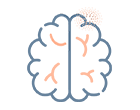Neurofibromatosis Precision Panel
Neurofibromatosis type 1 (NF1) and type 2 (NF2) are neurocutaneous congenital disorders that affect organs of ectodermal origin including skin, central nervous system, and the eyes.


Neurofibromatosis type 1 (NF1) and type 2 (NF2) are neurocutaneous congenital disorders that affect organs of ectodermal origin including skin, central nervous system, and the eyes. All are inherited in an autosomal dominant pattern and are characterized by a high rate of mutational change occurring for the first time in an individual as well as variable expression. NF1 and NF2 differ with regards to their age of onset, clinical manifestations, gene loci, and gene protein products. However, in both conditions, the altered gene products have a crucial role in the dysregulation of tumor suppression. NF1, also known as von Recklinghausen syndrome, includes effects on multiple systems of the body and the major associated tumor is the neurofibroma. In addition, clinical manifestations include bone dysplasia, learning disabilities, and increased risk of malignancy. NF2 includes schwannomas of multiple cranial and spinal nerves, among others.
The Igenomix Neurofibromatosis Precision Panel can serve as a diagnostic tool ultimately leading to a better management and prognosis of the disease. It provides a comprehensive analysis of the genes involved in this disease using next-generation sequencing (NGS) to fully understand the spectrum of relevant genes involved, and their high or intermediate penetrance.
The clinical utility of this panel is:
Plotkin, S. R., & Wick, A. (2018). Neurofibromatosis and Schwannomatosis. Seminars in neurology, 38(1), 73–85. https://doi.org/10.1055/s-0038-1627471
Korf B. R. (2013). Neurofibromatosis. Handbook of clinical neurology, 111, 333–340. https://doi.org/10.1016/B978-0-444-52891-9.00039-7
Spyk, S., Thomas, N., Cooper, D., & Upadhyaya, M. (2011). Neurofibromatosis type 1-associated tumours: Their somatic mutational spectrum and pathogenesis. Human Genomics, 5(6), 623. doi: 10.1186/1479-7364-5-6-623
Pemov, A., Dewan, R., Hansen, N., Chandrasekharappa, S., Ray-Chaudhury, A., & Jones, K. et al. (2020). Comparative clinical and genomic analysis of neurofibromatosis type 2-associated cranial and spinal meningiomas. Scientific Reports, 10(1). doi: 10.1038/s41598-020-69074-z
Farschtschi, S., Mautner, V. F., McLean, A., Schulz, A., Friedrich, R. E., & Rosahl, S. K. (2020). The Neurofibromatoses. Deutsches Arzteblatt international, 117(20), 354–360. https://doi.org/10.3238/arztebl.2020.0354
Cimino, P. J., & Gutmann, D. H. (2018). Neurofibromatosis type 1. Handbook of clinical neurology, 148, 799–811. https://doi.org/10.1016/B978-0-444-64076-5.00051-X